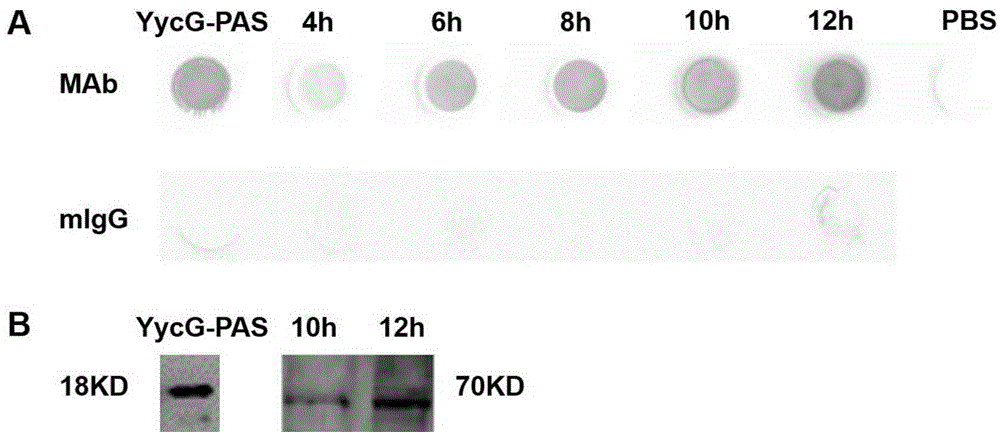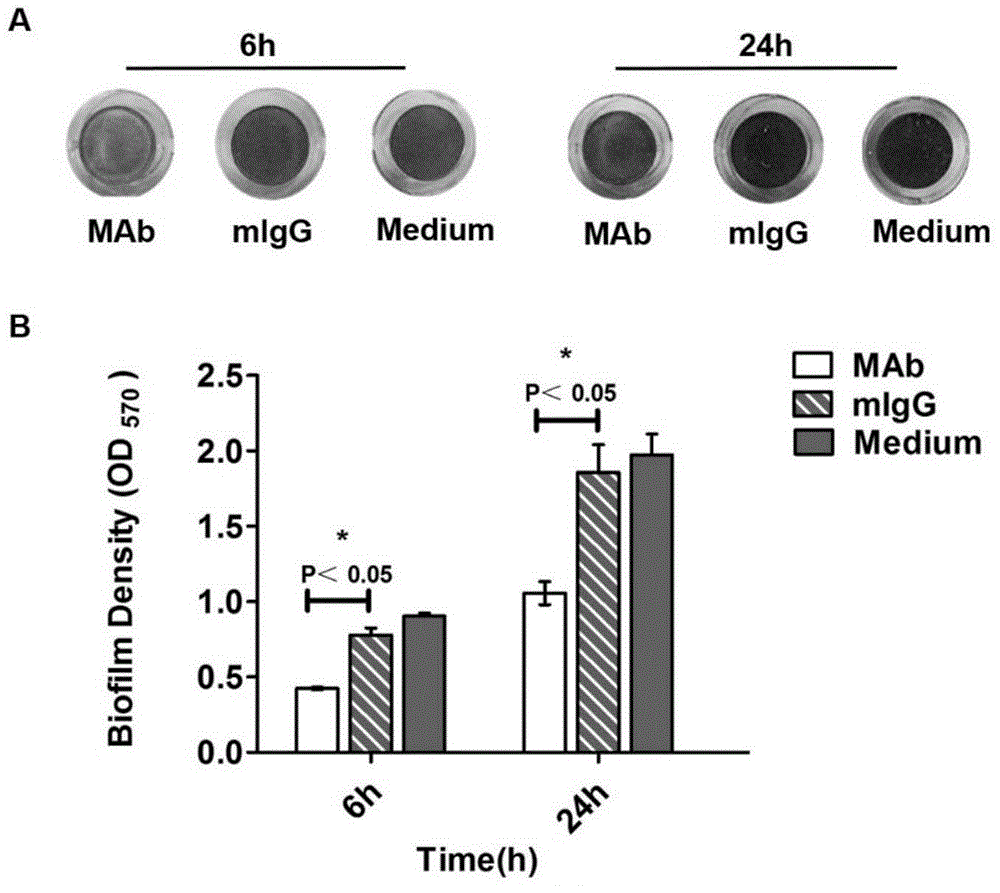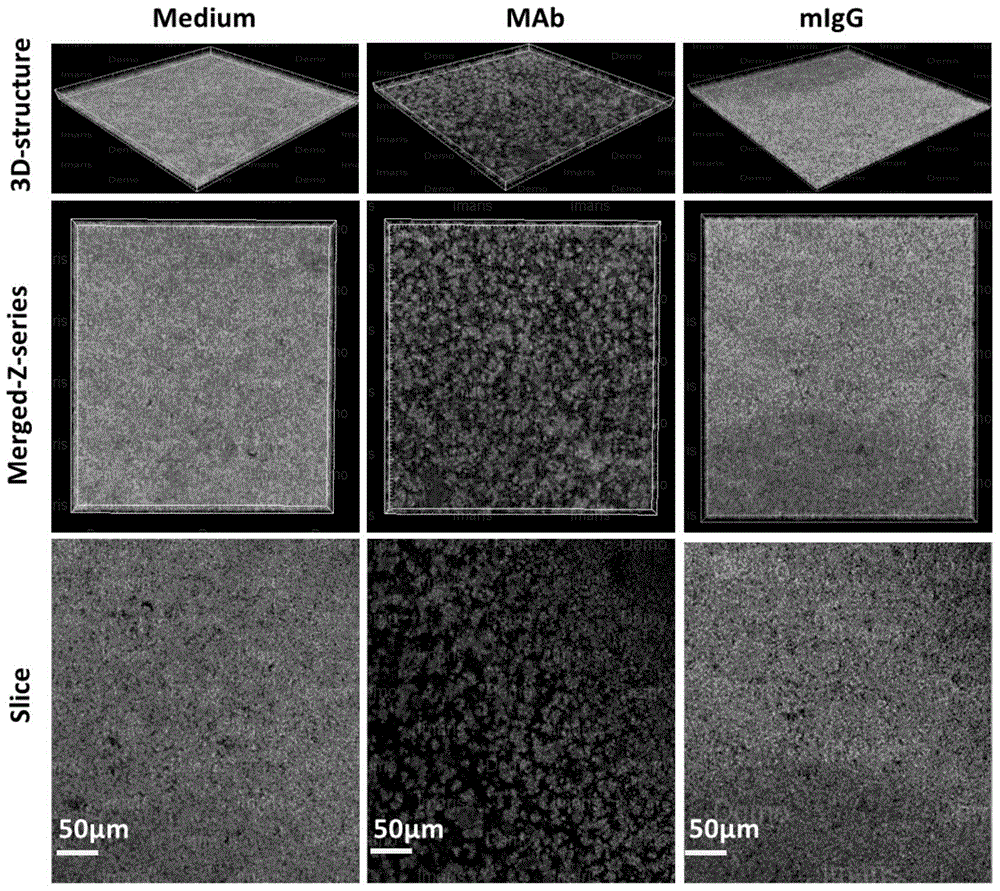YycG-PAS monoclonal antibody and application thereof
A technology of monoclonal antibody and application, applied in the direction of antibody, antibacterial drug, anti-enzyme immunoglobulin, etc.
- Summary
- Abstract
- Description
- Claims
- Application Information
AI Technical Summary
Problems solved by technology
Method used
Image
Examples
Embodiment 1
[0029] Example 1 Preparation of YycG-PAS monoclonal antibody:
[0030] Amplify and amplify the pas fragment (nt 100 to 552 bp) of the yycG extracellular signal sensing region from the genomic DNA of Staphylococcus epidermidis ATCC 35984 strain, connect with the prokaryotic expression vector pET28a plasmid and express the DNA in Escherichia coli BL21 Fragment encoded YycG-PAS protein.
[0031] Using Ni 2+ The YycG-PAS protein was purified by affinity chromatography, TEV protease hydrolyzed protein tag, molecular sieve and other methods to prepare the recombinant YycG-PAS protein for immunized mice.
[0032]The present invention uses the PAS region (the 34th to 184th amino acid) of Staphylococcus epidermidis YycG protein as an antigen, and immunizes Balb / c mice to prepare a YycG-PAS monoclonal antibody. The measurement results show that the monoclonal antibody is small Mouse IgG.
Embodiment 2
[0033] Example 2 The ELISA method was used to detect the binding force of the YycG-PAS monoclonal antibody to the recombinant protein, and to detect its specificity in recognizing bacterium protein by immunospot method (Dot blot) and Western blot method (Western blot)
[0034] The ELISA detection method for the binding ability of YycG-PAS monoclonal antibody to YycG-PAS protein is as follows:
[0035] The monoclonal antibody with a stock solution concentration of 5 mg / mL was serially diluted 2-fold, and then added to the 96-well ELISA plate coated with YycG-PAS protein, and incubated at 37°C for 1 hour. After washing the plate repeatedly, add HRP-labeled goat anti-mouse secondary antibody and incubate at 37°C for 1 hour. After washing the plate repeatedly, add the chromogenic substrate to incubate the color development and terminate the reaction, and read the absorbance values of each well at 450nm and 630nm.
[0036] Table 1 shows the ELISA detection results of YycG-PAS mo...
Embodiment 3
[0045] Example 3 YycG-PAS monoclonal antibody inhibits the formation of Staphylococcus epidermidis biofilm
[0046] Using trace bacterial biofilm detection test (96-well plate biofilm formation test), YycG-PAS monoclonal antibody was mixed with Staphylococcus epidermidis biofilm-forming positive strain ATCC 35984 strain (final concentration 80 μg / mL), and inoculated in 96-well plate on, 37°C for 6 or 24 hours. The bacterial biofilm was detected by the crystal violet staining method, and after washing with crystal violet staining, the strength of the bacterial biofilm formation was judged according to the A570 reading. The experimental method is as follows:
[0047] 1. Staphylococcus epidermidis was inoculated in fresh TSB medium and cultured overnight at 37°C.
[0048] 2. Inoculate the overnight cultured ATCC 35984 strain bacterium solution (3 μL) in a 96-well plate containing 80 μg / mL YycG-PAS monoclonal antibody (200 μl per well); normal mouse IgG (80 μg / mL) at the same co...
PUM
 Login to View More
Login to View More Abstract
Description
Claims
Application Information
 Login to View More
Login to View More - R&D
- Intellectual Property
- Life Sciences
- Materials
- Tech Scout
- Unparalleled Data Quality
- Higher Quality Content
- 60% Fewer Hallucinations
Browse by: Latest US Patents, China's latest patents, Technical Efficacy Thesaurus, Application Domain, Technology Topic, Popular Technical Reports.
© 2025 PatSnap. All rights reserved.Legal|Privacy policy|Modern Slavery Act Transparency Statement|Sitemap|About US| Contact US: help@patsnap.com



